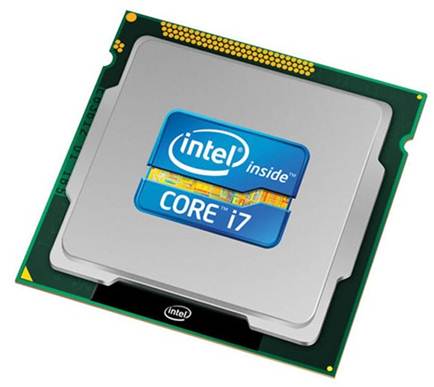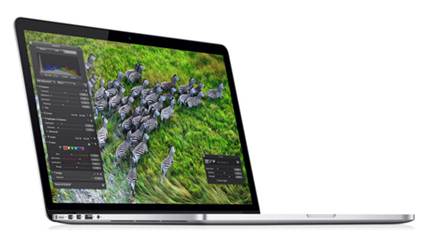This we weren’t expecting. Not just an
update, but two brand new iMacs, redesigned from scratch. The front panel) with
its edge-to-edge glass and aluminium ‘chin’, looks the same as before) but
there the resemblance ends; it’s fused, by a new process called friction stir
welding in which ‘the actual molecules of the aluminium are merged together’)
to a new unibody case that’s 80% thinner, tapering to just 5mm at the edges. As
usual, this is streets ahead of what anyone else is doing, and what we can now
predict with some confidence is that when we get our hands on these machines
we’re going to like them. As are many, many other people...
iMac
Configuration
21.5-inch iMac 2.7GHz
·
Price: $1,648.5
·
CPU: 2.7GHz Quad-core Intel Core iS
·
RAM: 8GB (maximum 16GB, not user upgradable)
·
Hard disk: 1TB (no options)
·
Graphics: NVIDIA GeForce GT 640M with 512MB
video RAM

21.5-inch
iMac 2.7GHz
21.5-inch iMac
2.9GHz
·
Price: $1,873.5
·
CPU: 2.9GHz Quad-core Intel Core i5 (3.1GHz
£TBC)
·
RAM: 8GB (maximum 16GB, not user-upgradable)
·
Hard disk: 1TB (1TB Fusion £TBC)
·
Graphics: NVIDIA GeForce GT 640M with 512MB
video RAM
27-inch iMac
2.7GHz
·
Price: $2,248.5
·
CPU: 27GHz Quad-core Intel Core i5
·
RAM: 8GB (user-upgradable, maximum 32GB)
·
Hard disk: 1TB (options TBC)
·
Graphics: NVIDIA GeForce GTX 660M with 512MB
video RAM
27-inch iMac 3.2GHz
·
Price: $2,548.5
·
CPU: 3.2GHz Quad-core Intel Core i5 (3.4GHz i7
£TBC)
·
RAM: 8GB (user-upgradable, maximum 32GB)
·
Hard disk: 1TB (3TB, 1TB or 3TB Fusion, 768GB
SSD £TBC)
·
Graphics: NVIDIA GeForce GT 675MX with 1GB video
RAM (GTX 680MX with 2GB)
Performance
Although the four standard configurations
of the new iMacs are all based on Core i5 processors, these Ivy Bridge chips
should be noticeably faster than the earlier generation in the previous iMac
range. As usual, the route to pro performance is to pick the top model) then
max out the build to order options, which include a 3.4GHz i7 CPU and GeForce
GTX 680MX Graphics - the highest- performing GPU available in an all-in-one
computer. Prices for these have yet to be announced, so there’s still time to
order and drink a treble of your favourite whisky before enquiring

3.4GHz
i7 CPU
Input
Apple’s wireless keyboard, which lacks a
numeric keypad, and a Magic Mouse are included with the iMac. You can swap for
a Magic Trackpad and/or a wired keyboard with keypad
Mac Mini
The Mac Mini isn’t much changed. Really not
much. At all. In fact, if you took apart the new and old models on the same
bench and forgot which components were which, it probably wouldn’t matter. What
does matter is that the CPUs are now Ivy Bridge, promising improved performance
when we get our benchmarks running on this hardware in the next week or so, and
the ports now include USB3, giving you a wider choice of equally speedy
external peripherals.

The
Mac Mini isn’t much changed.
Fusion drive
Both the Mac mini and the iMac now have a
third storage option in addition to all-mechanical hard disks and all-silicon
SSDs: Apple’s new Fusion drive. This combines 128G B of flash memory with 1TB
or 3TB of Hard disk space into a virtual drive that acts just
like one big disk but lets your Mac access commonly used files, including apps,
much faster. At $300 more than the equivalent plain hard disk, it could be a
cost effective way to get high capacity with high performance. We’ll bring you
more details of how it works and the pros and cons next issue
MacBook Pro 13in Retina
Perhaps Churlishly, the question most asked
aboutthe15-inchMacBookProwith Retina Display when it was launched in June was
‘What abouta13-inch?’ Well, here it is. As with the regular MacBooks,it has a
lower spec than the larger model, relying on Intel HD 4000Graphics (like the
Mac mini) where the 15in Retina has a dedicated NVIDIA GPU. But it’s just as
pretty.

MacBook
Pro 13in Retina
iBooks Author 2.0
The Lack Of custom font embedding was a
major flaw in the first version of iBooks Author, the iWork like Mac app
released by Apple in January to enable publishers to create interactive
textbooks for the iPad. That’s been fixed, and there’s now support for maths
typesetting and portrait-only books too, as well as more multi-touch elements.
We’ll have a hands-on review next issue.

Hands-on
with iBooks Author 2.0
iPad with Retina Display
When The Third iPad was introduced earlier
this year as the ‘new iPad’, we wondered where Apple was going to go from there
with the naming. But we didn’t expect the issue to arise quite so soon. The
‘iPad with Retina Display’, as it’s officially known (the old new one already
had a Retina Display, of course), was introduced by Phil Schiller as the
‘fourth generation iPad’, so we’re to think of it as the iPad 4, not an iPad 3.5
or 35. Justifying that are a number of significant upgrades, including a new
A6X processor that Apple reckons is twice as fast as the previous A5X in both CPU
and GPU tasks, and the inevitable switch from the 30-pin Dock to the Lightning
connector, as seen on the iPhone 5, the new iPod touch and now the iPad mini.
So this isn’t an iPad that looks different or can offer radical new
functionality, but it’s an iPad that’s even better than the previous stunning
iPad, at the same price.

When
The Third iPad was introduced earlier this year as the ‘new iPad’, we wondered
where Apple was going to go from there with the naming.
iPad mini
Why Do We need a smaller iPad? The business
case is obvious: Apple’s competitors are selling smaller tablets successfully.
But what Apple did for the first time on 23 October was to show how a smaller
format could actually be useful, and it did so in a single image of a hand
gripping the 7.9-inch iPad mini at both sides.
This at once explained how it would handle
more flexibly and why it had been designed with new proportions. The narrowed
side bezels reduce the width just enough to fit most hands while maximising the
screen area.
The screen itself has exactly the same 1024
x 768 pixels as the original iPad and iPad 2, so all the 275,000 apps that have
already been designed for iPad will run without modification, the slightly
smaller pixels increasing sharpness without substantially affecting usability.

The
business case is obvious: Apple’s competitors are selling smaller tablets
successfully.
It all makes sense now.
Fine details
Elements like the perforated speaker
grilles and diamond cut chamfers are reminiscent of the iPhone 5, demonstrating
what Schiller called ‘a level of tolerances unseen in our industry I’ve
explained that the chamfers ‘meet seamlessly with the glass I think it’s a
beautiful detail that further reduces parts and actually makes it more durable’
The case essentially has only two pieces) the aluminium uni-body and the glass
front) both of which can only be so thin because of the quality of their
materials. The LCD Display panel is just 0.12mm thick and is laminated between
0.2mm sheets of glass. Such specifications also contribute to the device’s
lightness: although the iPad mini doesn’t look an enormous amount smaller than
the original when they’re placed side by side, it weighs only half as much. ‘We
wanted to say it weighed the same as a [paperback] book,’ said Schiller. ‘But a
book actually weighs much more.’
App
Unlike the iPad 2, the mini supports Sin as
well as FaceTime (wifi or 3G) and Maps. Both of its cameras have been upgraded,
and it can stream 1080p to Apple TV.